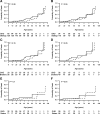Longevity in untreated congenital growth hormone deficiency due to a homozygous mutation in the GHRH receptor gene
- PMID: 19965916
- PMCID: PMC2840870
- DOI: 10.1210/jc.2009-1879
Longevity in untreated congenital growth hormone deficiency due to a homozygous mutation in the GHRH receptor gene
Abstract
Context: Reduced longevity observed in hypopituitarism has been attributed to GH deficiency (GHD). It is, however, unclear whether GHD or other confounding factors cause this early mortality.
Objective: The aim was to study longevity in subjects from a large kindred with untreated, lifetime isolated GHD (IGHD) due to a homozygous mutation in the GHRH receptor gene and in heterozygous carriers of the mutation.
Design, setting, and participants: We carried out a retrospective cohort study on three groups. We first compared mortality risk of 65 IGHD individuals and their 128 unaffected siblings from 34 families. We then compared mean age of death of the IGHD to the general population. A transversal study was carried out to compare the rate of heterozygosity for the mutation in two groups of young (20-40 yr old) and old (60-80 yr old) normal-appearing subjects from the same county.
Main outcome measure: We measured longevity.
Results: The risk of death of IGHD subjects was not different from their siblings. Life span in IGHD individuals was shorter than the general population. When stratified by sex, this difference persisted only in females, due to a high frequency of IGHD deaths in females aged 4-20. There was no significant difference in life span between IGHD subjects and siblings or the general population when analyzing subjects who reached age 20. The prevalence of heterozygosity did not differ in young and old groups, suggesting no survival advantage or disadvantage.
Conclusions: In a selected genetic background, lifelong untreated IGHD does not affect longevity.
Figures
Similar articles
-
Growth hormone releasing hormone receptor (GHRH-r) gene mutation in Indian children with familial isolated growth hormone deficiency: a study from western India.J Pediatr Endocrinol Metab. 2005 Oct;18(10):955-73. doi: 10.1515/jpem.2005.18.10.955. J Pediatr Endocrinol Metab. 2005. PMID: 16355809
-
Lack of evidence of premature atherosclerosis in untreated severe isolated growth hormone (GH) deficiency due to a GH-releasing hormone receptor mutation.J Clin Endocrinol Metab. 2006 Jun;91(6):2093-9. doi: 10.1210/jc.2005-2571. Epub 2006 Mar 7. J Clin Endocrinol Metab. 2006. PMID: 16522693
-
Ocular findings in adult subjects with an inactivating mutation in GH releasing hormone receptor gene.Growth Horm IGF Res. 2017 Jun;34:8-12. doi: 10.1016/j.ghir.2017.04.002. Epub 2017 Apr 21. Growth Horm IGF Res. 2017. PMID: 28456063
-
Hypothalamic abnormalities: Growth failure due to defects of the GHRH receptor.Growth Horm IGF Res. 2018 Feb;38:14-18. doi: 10.1016/j.ghir.2017.12.011. Epub 2017 Dec 20. Growth Horm IGF Res. 2018. PMID: 29277338 Review.
-
Phenotype-genotype correlations in congenital isolated growth hormone deficiency (IGHD).Indian J Pediatr. 2012 Jan;79(1):99-106. doi: 10.1007/s12098-011-0614-7. Epub 2011 Dec 3. Indian J Pediatr. 2012. PMID: 22139958 Review.
Cited by
-
Cerebral vasoreactivity, a surrogate marker of cerebrovascular disease, is not impaired in subjects with lifetime, untreated, congenital isolated GH deficiency.Endocrine. 2020 Nov;70(2):388-395. doi: 10.1007/s12020-020-02415-0. Epub 2020 Jul 12. Endocrine. 2020. PMID: 32656695
-
Standardizing protocols dealing with growth hormone receptor gene disruption in mice using the Cre-lox system.Growth Horm IGF Res. 2018 Oct-Dec;42-43:52-57. doi: 10.1016/j.ghir.2018.08.003. Epub 2018 Aug 29. Growth Horm IGF Res. 2018. PMID: 30195091 Free PMC article.
-
The GH/IGF-1 axis in ageing and longevity.Nat Rev Endocrinol. 2013 Jun;9(6):366-376. doi: 10.1038/nrendo.2013.67. Epub 2013 Apr 16. Nat Rev Endocrinol. 2013. PMID: 23591370 Free PMC article. Review.
-
Impact of Growth Hormone-Related Mutations on Mammalian Aging.Front Genet. 2018 Nov 27;9:586. doi: 10.3389/fgene.2018.00586. eCollection 2018. Front Genet. 2018. PMID: 30542372 Free PMC article. Review.
-
The state of Sergipe contribution to GH research: from Souza Leite to Itabaianinha syndrome.Arch Endocrinol Metab. 2022 Nov 17;66(6):919-928. doi: 10.20945/2359-3997000000567. Arch Endocrinol Metab. 2022. PMID: 36394485 Free PMC article. Review.
References
-
- vB Hjelmborg J, Iachine I, Skytthe A, Vaupel JW, McGue M, Koskenvuo M, Kaprio J, Pedersen NL, Christensen K 2006 Genetic influence on human longevity. Hum Genet 119:312–321 - PubMed
-
- Kenyon C, Chang J, Gensch E, Rudner A, Tabtiang R 1993 A C. elegans mutant that lives twice as long as wild-type. Nature 366:461–464 - PubMed
-
- Fabrizio P, Pozza F, Pletcher SD, Gendron CM, Longo VD 2001 Regulation of longevity and stress resistance by Sch9 in yeast. Science 292:288–290 - PubMed
-
- Tatar M, Kopelman A, Epstein D, Tu MP, Yin CM, Garofalo RS 2001 A mutant Drosophila insulin receptor homologue that extends life span and impairs neuroendocrine function. Science 292:107–110 - PubMed
Publication types
MeSH terms
Substances
Grants and funding
LinkOut - more resources
Full Text Sources
Other Literature Sources


